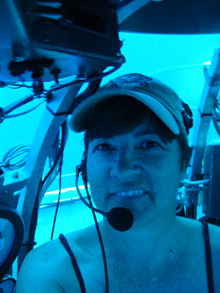Top 43 Quotes & Sayings by Edith Widder
Explore popular quotes and sayings by an American scientist Edith Widder.
Last updated on April 19, 2025.
The primary way that we know about what lives in the ocean is we go out and drag nets behind ships. And I defy you to name any other branch of science that still depends on hundreds-of-year-old technology. The other primary way is we go down with submersibles and remote- operated vehicles. I've made hundreds of dives in submersibles.
I had wanted to place the Eye-in-the-Sea at an oasis on the bottom of the ocean, in some site rich with life that was likely to be patrolled by large predators. The first time I got to test the camera at such a place was in 2004, in the north end of the Gulf of Mexico, at an amazing location called the brine pool.
There's a lot of animals in the open ocean - most of them that make light. And we have a pretty good idea, for most of them, why. They use it for finding food, for attracting mates, for defending against predators. But when you get down to the bottom of the ocean, that's where things get really strange.
In 2008, the Nobel Prize in Chemistry was awarded for work done on a molecule called green fluorescent protein that was isolated from the bioluminescent chemistry of a jellyfish, and it's been equated to the invention of the microscope in terms of the impact that it has had on cell biology and genetic engineering.
Since my first dive in a deep-diving submersible, when I went down and turned out the lights and saw the fireworks displays, I've been a bioluminescence junky. But I would come back from those dives and try to share the experience with words, and they were totally inadequate to the task. I needed some way to share the experience directly.
Exploring is an innate part of being human. We're all explorers when we're born. Unfortunately, it seems to get drummed out of many of us as we get older, but it's there, I think, in all of us. And for me that moment of discovery is just so thrilling, on any level, that I think anybody that's experienced it is pretty quickly addicted to it.
For my Ph.D. thesis, I was measuring the electrical activity that triggers light emission from a bioluminescent dinoflagellate. As I was nearing the completion of my degree, my major professor wrote a grant for an instrument for measuring the color of very dim light flashes from bioluminescent animals.





















